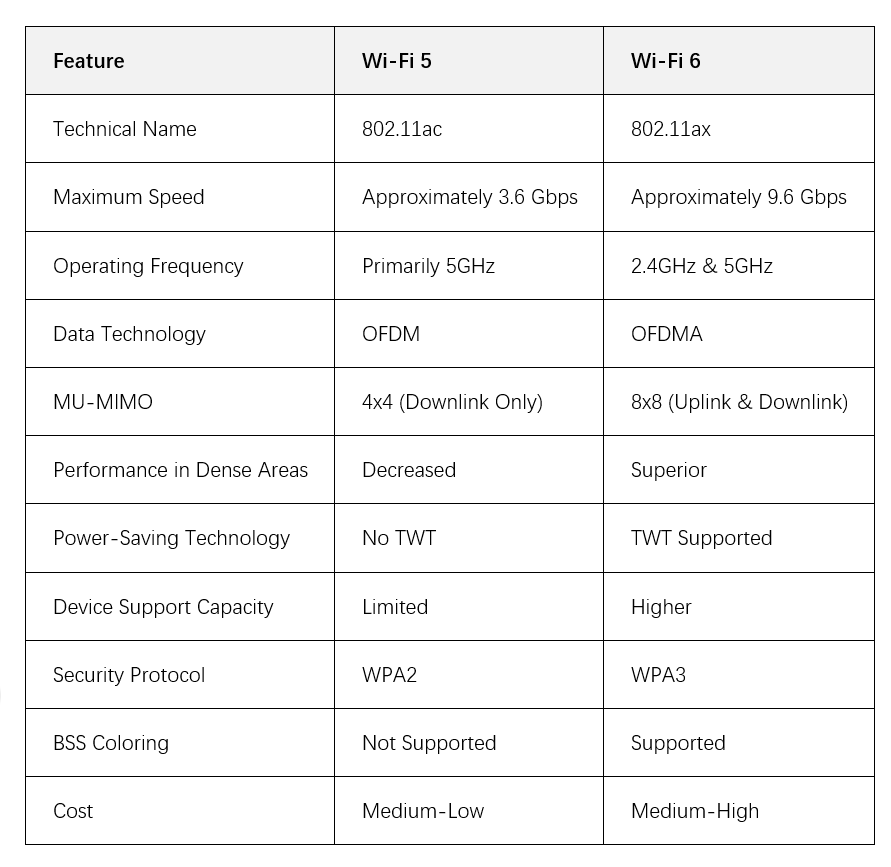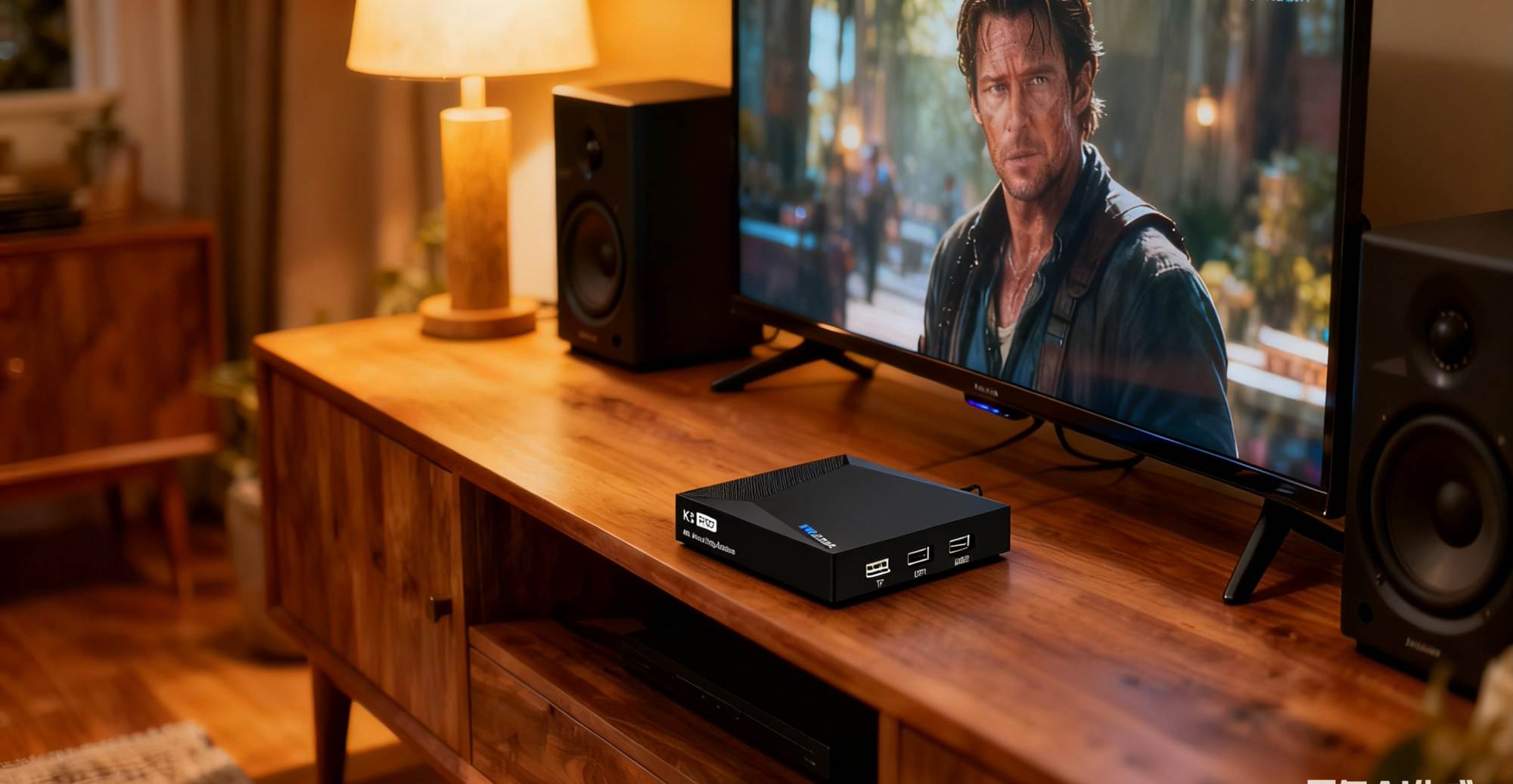If you've ever been confused by various Wi-Fi terms, this article will explain these technical terms in a simple and easy-to-understand way, clarifying the core differences between Wi-Fi 5 and Wi-Fi 6, and explaining how they affect the user experience of various devices.
Contents
Understanding Wi-Fi 5 and Wi-Fi 6
Speed and Data Transfer Capabilities Comparison
Key Technology Differences Analysis
Device Compatibility Analysis
Performance in High-Density Connection Environments
Security Comparison
Summary and Purchase Recommendations
Understanding Wi-Fi 5 and Wi-Fi 6
First, let's understand the basic concepts. The core differences between Wi-Fi 5 and Wi-Fi 6 lie in transmission speed, data efficiency, and the ability to stably connect multiple devices simultaneously.
● Wi-Fi 5: As the fifth generation of Wi-Fi technology, it was introduced in 2013 and primarily operates in the 5GHz band. Compared to its predecessor, it offers a significant speed improvement, effectively supporting high-definition video streaming, online gaming, and web browsing.
● Wi-Fi 6: This is the latest universal standard released in 2019, supporting both the 2.4GHz and 5GHz bands. Not only is it faster, with a theoretical peak speed of 9.6 Gbps, it can also efficiently connect a large number of devices simultaneously. Think of it as upgrading from a two-lane highway to an eight-lane one, significantly enhancing data flow capabilities.
It's worth noting that following Wi-Fi 6, next-generation technologies such as Wi-Fi 7 and Wi-Fi 8 are also under development. Wi-Fi 7 will support three frequency bands: 2.4GHz, 5GHz, and 6GHz, offering significant speed improvements and further optimizing bandwidth sharing among multiple devices. Wi-Fi 8, currently under development, focuses more on connection stability, reduced latency, and reliability in complex environments.

Speed and Data Transfer Capabilities Comparison
Speed is usually the first indicator users focus on.
●Wi-Fi 5: Maximum theoretical speed of 3.6 Gbps
●Wi-Fi 6: Maximum theoretical speed of 9.6 Gbps
It's important to clarify that this speed refers to the maximum transmission rate between your internal network devices (such as mobile phones and routers), and will not exceed the speed of your data plan purchased from your carrier. However, a higher theoretical speed means improved data transfer efficiency. For example, a TV box that supports Wi-Fi 6 can smoothly play 4K or even 6K videos, effectively avoiding buffering, even when multiple devices are connected to the internet simultaneously.
Key Technology Differences Explained
Here are some simple explanations of key technical points:
1. OFDM vs. OFDMA
● Wi-Fi 5 (OFDM): Can only send one complete data packet to one device at a time.
● Wi-Fi 6 (OFDMA): Can divide a data packet into multiple smaller pieces and send them to different devices simultaneously.
Analogy: This is like a teacher. OFDM is like a teacher tutoring one student at a time; while OFDMA is like a teacher lecturing to multiple groups of students simultaneously, resulting in higher overall teaching efficiency.
2. BSS Coloring
● Wi-Fi 5: Does not have this feature.
● Wi-Fi 6: Adds BSS coloring, which effectively identifies and reduces signal interference from nearby Wi-Fi networks.
Analogy: Imagine multiple routers as people talking in the same room. Wi-Fi 6 can assign different "color tags" to each person's voice, allowing your device to accurately identify and focus on the sounds it needs to hear, thus avoiding crosstalk.

3. MU-MIMO
●Wi-Fi 5: Supports 4x4 MU-MIMO, but only for downlink data (such as downloads).
●Wi-Fi 6: Supports the more powerful 8x8 MU-MIMO, and is applicable to both uplink (such as uploads) and downlink data.
Analogy: Wi-Fi 5 is like a highway with only four lanes, allowing efficient one-way traffic (downloads). Wi-Fi 6 is like a modern highway with eight lanes, supporting high-speed two-way traffic.
4. Target Wake-up Time
●Wi-Fi 5: Does not have this feature; devices need to maintain a continuous communication state, ready to receive data at any time, resulting in higher power consumption.
●Wi-Fi 6: Introduces the Target Wake-up Time feature, allowing routers to schedule specific communication times for each connected device (such as mobile phones, smart home sensors).
Value:
● Energy Saving: Devices can enter a "sleep" state during off-peak hours, significantly extending battery life.
● Reduced Load: Off-peak communication reduces network congestion.
● High Efficiency: All devices can send and receive data promptly at scheduled times, reducing latency.

Device Compatibility Analysis
There are significant differences in the number of connected devices:
● Wi-Fi 5: Limited number of stable connections; speeds tend to drop in densely populated environments.
● Wi-Fi 6: Can provide connections for more devices simultaneously without significant speed degradation.
Scenario: In a modern home with more than 10 smart devices, Wi-Fi 6 can easily handle all connectivity needs. However, when family members are simultaneously streaming video, holding online meetings, or playing games, Wi-Fi 5 networks may struggle. This is especially important for TV boxes; a streaming device that supports Wi-Fi 6 can ensure smooth playback of high-definition video even in complex network environments with multiple devices online simultaneously.

Performance in High-Density Connectivity Environments
In densely populated environments such as apartment buildings, offices, and shopping malls, Wi-Fi 6, with its OFDMA and MU-MIMO technologies, offers a faster and more stable connection experience than Wi-Fi 5.
Analogy: Imagine a busy airport. Wi-Fi 5 is like having only one check-in counter, forcing all passengers to wait in long lines. Wi-Fi 6, on the other hand, is like having multiple dedicated counters, simultaneously processing passengers from different flights, significantly improving overall efficiency.
Security Differences
Regarding network security:
●Wi-Fi 5: Primarily uses the WPA2 security protocol, which has relatively low security.
●Wi-Fi 6: Mandatory support for the latest WPA3 protocol, more effectively protecting user data from attacks and significantly increasing the difficulty of password cracking.

Summary
If you prioritize a high-quality, smooth streaming experience, Wi-Fi 6 is the wiser choice. It handles multiple devices connected simultaneously better, reducing video buffering and maintaining stable image quality—even during peak network usage.
The table above clearly compares the features of Wi-Fi 5 and Wi-Fi 6. Devices that support Wi-Fi 6 are typically more expensive, but this investment yields more advanced technology, faster speeds, stronger multi-device connectivity, and longer battery life for end devices.












